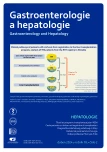Liver transplantation for acute liver failure
Authors:
E. Kieslichová 1,2
Authors place of work:
Klinika anesteziologie, resuscitace a intenzivní péče, Institut klinické a experimentální medicíny, Praha 2 1. LF Univerzity Karlovy, Praha
1
Published in the journal:
Gastroent Hepatol 2024; 78(2): 95-100
Category:
Hepatologie
doi:
https://doi.org/10.48095/ccgh202495
Summary
Acute liver failure is a rare, highly devastating, potentially reversible condition characterised by the sudden onset of severe liver dysfunction in individuals without pre-existing liver disease and with a poor prognosis. In recent decades, advances in the diagnosis of the disease, a better understanding of its pathophysiology and the development of supportive care have improved the prognosis of patients with acute liver failure. However, despite the success of conservative therapy, urgent liver transplantation remains the only chance of survival for a large proportion of patients with acute liver failure. Early diagnosis of the disease, implementation of supportive care and identification of patients indicated for urgent liver transplantation are essential measures in the management of patients with acute liver failure.
Keywords:
acute liver failure – transplantation – supportive therapy – prognostic criteria
Zdroje
1. Lucey MR, Furuya KN, Foley DP. Liver transplantation. N Engl J Med 2023; 389 (20): 1888–1900. doi: 10.1056/NEJMra2200923.
2. Germani G, Theocharidou E, Adam R et al. Liver transplantation for acute liver failure in Europe: outcomes over 20 years from the ELTR database. J Hepatol 2012; 57 (2): 288–296. doi: 10.1016/j.jhep.2012.03.017.
3. European Association for the Study of the Liver. EASL Clinical Practical Guidelines on the management of acute (fulminant) liver failure. J Hepatol 2017; 66 (5): 1047–1081. doi: 10.1016/ j.jhep.2016.12.003.
4. Bernuau J, Benhamou JP. Classifying acute liver failure. Lancet 1993; 342 (8866): 252–253. doi: 10.1016/0140-6736 (93) 91809-z.
5. O’Grady JG, Schalm SW, Williams R. Acute liver failure: redefining the syndromes. Lancet 1993; 342 (8866): 273–275. doi: 10.1016/0140- 6736 (93) 91818-7.
6. Seetharam A. Intensive care management of acute liver failure: considerations while awaiting liver transplantation. J Clin Transl Hepatol 2019; 7 (4): 384–391. doi: 10.14218/JCTH.2019.00032.
7. Balackmore L, Bernal W. Acute liver failure. Clin Med 2015; 15 (5): 468–472. doi: 10.7861/clin medicine.15-5-468.
8. Lee WM. Etiologies of acute liver failure. Semin Liver Dis 2008; 28 (2): 142–152. doi: 10.1055/s-2008-1073114.
9. Wong NZ, Reddy KR, Bittermann T. Acute liver failure etiology is an independent predictor of waitlist outcome but not posttransplantation survival in a national cohort. Liver Transpl 2022; 28 (1): 39–50. doi: 10.1002/lt.26187.
10. Punzalan CS, Barry CT. Acute liver failure: diagnosis and management. J Intensive Care Med 2016; 31 (10): 642–653. doi: 10.1177/0885066615609271.
11. Montrief T, Koyfman A, Long B. Acute liver failure: a review for emergency physicians. Am J Emerg Med 2019; 37 (2): 329–337. doi: 10.1016/j.ajem.2018.10.032.
12. Shingina A, Mukhtar N, Wakim-Fleming J et al. Acute liver failure guidelines. Am J Gastroenterol 2023; 118 (7): 1128–1153. doi: 10.14309/ ajg.0000000000002340.
13. Khan R, Koppe S. Modern management of acute liver failure. Gastroenterol Clin North Am 2018; 47 (2): 313–326. doi: 10.1016/j.gtc.2018.01.005.
14. Warrillow SJ, Bellomo R. Preventing cerebral oedema in acute liver failure: the case for quadruple-H therapy. Anaesth Intensive Care 2014; 42 (1): 78–88. doi: 10.1177/0310057X1404200114.
15. Vasques F, Cavazza A, Bernal W. Acute liver failure. Curr Opin Crit Care 2022; 28 (2): 198–207. doi: 10.1097/MCC.0000000000000923.
16. Katarey D, Jalan R. Update on extracorporeal liver support. Curr Opin Crit Care 2020; 26 (2): 180–185. doi: 10.1097/MCC.0000000000000708.
17. Larsen FS, Schmidt LE, Bernsmeier C et al. Highvolume plasma exchange in patients with acute liver failure: an open rando mised controlled trial. J Hepatol 2016; 64 (1): 69–78. doi: 10.1016/j.jhep.2015.08.018.
18. Tujios S, Stravitz RT, Lee WM. Management of acute liver failure: update 2022. Semin Liver Dis 2022; 42 (3): 362–378. doi: 10.1055/s-0042-1755274.
19. Castaldo ET, Chari RS. Liver transplantation for acute hepatic failure. HPB (Oxford) 2006; 8 (1): 29–34. doi: 10.1080/13651820500465741.
20. McPhail MJ, Farne H, Senvar N et al. Ability of King’s college criteria and model for end-stage liver disease scores to predict mortality of patients with acute liver failure: a meta-analysis. Clin Gastroenterol Hepatol 2016; 14 (4): 516–525. doi: 10.1016/j.cgh.2015.10.007.
21. Ichai P, Legeai C, Francoz C et al. Patients with acute liver failure listed for superurgent liver transplantation in France: reevaluation of the ClichyVillejuif criteria. Liver Transpl 2015; 21 (4): 512–523. doi: 10.1002/lt.24092.
22. Flamm SL, Yu XY, Singh S et al. American Gastroenterological Association Institute Guidelines for the diagnosis and management of acute liver failure. Gastroenterology 2017; 152 (3): 644–647. doi: 10.1053/j.gastro.2016.12.026.
23. Bernal W, Hyyryainen A, Gera A et al. Lessons from look-back in acute liver failure? A single centre experience of 3300 patients. J Hepatol 2013; 9 (1): 74–80. doi: 10.1016/j.jhep.2013.02.010.
24. Arora H, Thekkekandam J, Tesche L et al. Long-term survival after 67 hours of anhepatic state due to primary liver allograft nonfunction. Liver Transpl 2010; 16 (12): 1428–1433. doi: 10.1002/lt.22166.
25. European Association for the Study of the Liver. EASL Clinical Practice Guidelines: liver transplantation. J Hepatol 2016; 64 (2): 433–485. doi: 10.1016/j.jhep.2015.10.006.
26. Anand AC, Singh P. Neurological recovery after recovery from acute liver failure: is it complete? J Clin Exp Hepatol 2019; 9 (1): 99–108. doi: 10.1016/j.jceh.2018.06.005.
27. Bernal W, Wendon J. Acute liver failure. N Engl J Med 2013; 369 (26): 2525–2534. doi: 10.1056/NEJMra1208937.
ORCID autorky
E. Kieslichová 0000-0002-3930-623X.
Štítky
Dětská gastroenterologie Gastroenterologie a hepatologie Chirurgie všeobecnáČlánek vyšel v časopise
Gastroenterologie a hepatologie

2024 Číslo 2
- Metamizol jako analgetikum první volby: kdy, pro koho, jak a proč?
- Specifika v komunikaci s pacienty s ránou – laická doporučení
- Horní limit denní dávky vitaminu D: Jaké množství je ještě bezpečné?
- MUDr. Lenka Klimešová: Multioborová vizita může být klíčem k efektivnější perioperační léčbě chronické bolesti
Nejčtenější v tomto čísle
- Diagnostika alkoholovej choroby pečene u gastroenterológa
- Izoniazidom navodené poškodenie pečene sprevádzané ikterom
- První zkušenosti s filgotinibem ve vyšší linii léčby u pacientů s ulcerózní kolitidou
- Transplantace jater pro akutní selhání jater
